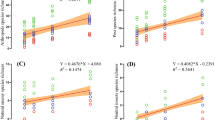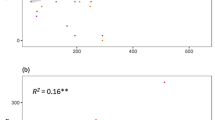Abstract
Arthropod communities in pear are conceptualized as hierarchically organized systems in which several levels of organization or subsystems can be recognized between the population level and the community as a whole. An individual pear tree is taken to be the community habitat with arthropod subcommunities developing on leaf, fruit, and wood subcommunity habitats. Each subcommunity is composed of trophically organized systems of populations. Each system of populations is comprised of a functional group or guild of phytophagous arthropods that use the habitat primarily for feeding but also for overwintering or egg deposition, and associated groups of specialized predators, parasitoids, and hyperparasitoids. Several species move from one subcommunity to another during the course of community development and thus integrate community subsystems.
Community development or change in organization through time is conceptualized as being jointly determined by the development of the habitat and the organization of the species pool. The influence of habitat development on community development within a species pool is emphasized in this research. Seasonal habitat development is expressed as change in the kinds and biomasses of developmental states of wood, leaf, and fruit subcommunity habitats. These changes are accompanied by changes in the kinds, biomasses, and distributions of associated community subsystems.
Similar content being viewed by others
Literature Cited
Allen, T. F. H., and T. B. Starr. 1982. Hierarchy: perspectives for ecological complexity. University of Chicago Press, Chicago. 310 pp.
Banerjee, B. 1983. Arthropod accumulation on tea in young and old habitats.Ecological Entomology 8:117–123.
Bethell, R. S. (ed.). 1978. Pear pest management. University of California, Berkeley. 234 pp.
Borror, D. J., D. M. DeLong, and C. A. Triplehorn. 1976. An introduction to the study of insects. Holt, Rinehart and Winston, New York. 812 pp.
Burts, E. C. 1983. Effectiveness of a soft-pesticide program on pear pests.Journal of Economic Entomology 76:936–941.
Burts, E. C., and A. H. Retan. 1973. Detection of pear psylla. Washington State Extension Manual 3069. 2 pp.
Challice, J. S. 1969. Studies on the nature, distribution and biosynthesis of phenolic compounds inPyrus andMalus. MSc thesis. Bath University, Bath, UK.
Challice, J. S. 1972. Chemotaxonomic studies inPyrus and related genera. PhD thesis. University of Bristol, Bristol, UK.
Challice, J. S., and M. N. Westwood. 1972. Phenolic compounds of the genusPyrus. IV.Phytochemistry 11:37–44.
Clements, F. 1916. Plant succession; an analysis of the development of vegetation. Carnegie Institute Washington Publication No. 242. 512 pp.
Ehler, L. E., K. G. Eveleens, and R. van den Bosch. 1973. An evaluation of some natural enemies of cabbage looper on cotton in California.Environmental Entomology 1:1009–1015.
Elton, C. S. 1966. The pattern of animal communities. Methuen, London. 432 pp.
Elton, C. S., and R. S. Miller. 1954. The ecological survey of animal communities: with a practical system of classifying habitats by structural characters.Journal of Ecology 42:460–496.
Flaherty, D. L. 1969. Ecosystem trophic complexity and densities of the Williamette mite,Eotetranychus willamettei (Acarina: Tetranychidae).Ecology 50:911–916.
Fye, R. E. 1983. Dispersal and winter survival of the pear psylla.Journal of Economic Entomology 76:311–315.
Gleason, H. A. 1917. The structure and development of the plant association.Bulletin of the Torrey Botanical Club 44:463–481.
Gleason, H. A. 1926. The individualistic concept of the plant association.Bulletin of the Torrey Botanical Club 53:331–368.
Gruys, P. 1982. Hits and misses. The ecological approach to pest control in orchards.Entomologia Experimentalis et Applicata 31:70–87.
Gut, L. J., C. E. Jochums, P. H. Westigard, and W. J. Liss. 1982a. Variations in pear psylla (Psylla pyricola) Foerster densities in southern Oregon pear orchards and its implications.Acta Horticulturae 124:101–111.
Gut, L. J., P. H. Westigard, W. J. Liss, and M. J. Willett. 1982b. Biological control of pear psylla: a potential within a potential.Proceedings of the Washington State Horticulture Association 77:194–198.
Hoyt, S. C. 1969. Integrated chemical control of insects and biological control of mites of apple in Washington.Journal of Economic Entomology 62:74–86.
Huffaker, C. B., and C. E. Kennett. 1956. Experimental studies on predation: predation and cyclamen mite populations on strawberries in California.Hilgardia 26:191–222.
Jaksic, F. M. 1981. Abuse and misuse of the term guild in ecological studies.Oikos 37:397–400.
Klecka, W. R. 1975. Discriminant analysis. Pages 434–467in N. H. Nie, C. H. Hull, J. G. Jenkins, K. Steinbrenner, and D. H. Bents (eds.), SPSS statistical package for the social sciences. McGraw Hill, New York.
Kogan, M. 1981. Dynamics of insect adaptation to soybean: impact of integrated pest management.Environmental Entomology 10:363–371.
Krantz, G. W. 1978. A manual of acarology. Oregon State University Book Stores, Corvallis, Oregon. 509 pp.
Lawton, J. H. 1978. Host-plant influences on insect diversity: the effects of space and time. Pages 105–125in L. A. Mound and N. Waloff (eds.), Diversity of insect faunas. Symposia of the Royal Entomological Society of London, Blackwell Scientific Publications, Oxford.
Lawton, J. H. 1983. Plant architecture and the diversity of phytophagous insects.Annual Review of Entomology 28:23–39.
Lawton, J. H., and D. R. Strong. 1981. Community patterns and competition in folivorous insects.American Naturalist 118:317–338.
Liss, W. J., and C. E. Warren. 1980. Ecology of aquatic systems. Pages 41–79in R. T. Lackey and L. A. Nielsen (eds.), Fisheries management. John Wiley & Sons, New York.
Liss, W. J., L. J. Gut, P. H. Westigard, and C. E. Warren. 1982. A perspective for understanding arthropod community organization and development in pear.Acta Horticulture 124:85–100.
Liss, W. J., L. J. Gut, P. H. Westigard, and C. E. Warren. 1986. Perspectives on arthropod community structure, organization, and development in agricultural crops.Annual Review of Entomology 31:455–478.
Madsen, H. F., P. H. Westigard, and R. L. Sisson. 1963. Observations on the natural control of pear psylla,Psylla pyricola Foerster, in California.Canadian Entomologist 95:837–844.
Mayse, M. A., and P. W. Price. 1978. Seasonal development of soybean arthropod communities in east central Illinois.Agro-Ecosystems. 4:387–405.
McMullen, R. D. 1964. Biological control of pear psylla.Proceedings of the Washington State Horticultural Association 60:79–82.
Messenger, P. S., E. Biliotti, and R. van den Bosch. 1976. The importance of natural enemies in integrated control. Pages 543–563in C. B. Huffaker and P. S. Messenger (eds.), Theory and practice of biological control. Academic Press, New York.
Meszaros, Z. and others. 1984. Results of faunistical and floristical studies in Hungarian apple orchards (Apple ecosystem research no. 26).Acta Phytopathologica Academiae Scientiarum Hungaricae 19:91–176.
Moran, V. C., and T. R. E. Southwood. 1982. The guild composition of arthropod communities in trees.Journal of Animal Ecology 51:289–306.
Oatman, E. R., and G. R. Platner. 1969. An ecological study of insect populations on cabbage in southern California.Hilgardia 40:1–40.
Pimental, R. A. 1979. Morphometrics, the multivariate analysis of biological data. Kendall/Hunt, Dubuque, Iowa. 276 pp.
Pimentel, D., and A. G. Wheeler Jr. 1973. Species and diversity of arthropods in the alfalfa community.Environmental Entomology 5:605–611.
Price, P. W. 1976. Colonization of crops by arthropods: non-equilibrium communities in soybean fields.Environmental Entomology 5:605–611.
Price, P. W. 1983. Hypotheses on organization and evolution in herbivorous insect communities. Pages 559–596in R. F. Denno and M. S. McClure (eds.), Variable plants and herbivores in natural and managed systems. Academic Press, New York.
Price, P. W. 1984. Communities of specialists: vacant niches in ecological and evolutionary time. Pages 510–523in D. R. Strong, D. Simberloff, L. G. Abele, and A. B. Thistle (eds.), Ecological communities: conceptual issues and the evidence. Princeton University Press, Princeton, New Jersey.
Richards, O. W., and R. G. Davies. 1977. Imms' general textbook of entomology, volume 2: classification and biology. John Wiley & Sons, New York.
Richardson, J. L. 1980. The organismic community: resilience of an embattled ecological concept.BioScience 30:465–471.
Root, R. B. 1973. Organization of a plant-arthropod association in simple and diverse habitats: the fauna of collards (Brassica oleracea).Ecological Monographs 43:95–124.
Roughgarden, J. and J. Diamond. 1986. Overview: the role of species interactions in community ecology. Pages 333–343in J. Diamond and T. J. Case (eds.), Community ecology. Harper & Row, New York.
Strong, D. R. Jr., D. Simberloff, L. G. Abele, and A. B. Thistle (eds.). 1984. Ecological communities: conceptual issues and the evidence. Princeton University Press, Princeton, New Jersey. 613 pp.
Waloff, N. 1968a. Studies on the insect fauna on scotch broomSarcothamnus scoparius (L.) Wimmer.Advances in Ecological Research 5:87–208.
Waloff, N. 1968b. A comparison of factors affecting different insect species on the same host plant. Pages 76–87in T. R. E. Southwood (ed.), Insect abundance. Symposia of the Royal Entomological Society of London, No. 4. Blackwell Scientific Publications, Oxford.
Warren, C. E., M. W. Allen, and J. W. Haefner. 1979. Conceptual frameworks and the philosophical foundations of general living systems theory.Behavioral Science 24:296–310.
Westigard, P. H. 1971. Integrated control of spider mites on pear.Journal of Economic Entomology 64:496–501.
Westigard, P. H. 1973a. Pest status of insects and mites on pear in southern Oregon.Journal of Economic Entomology 66:227–232.
Westigard, P. H. 1973b. The biology of an effect of pesticides onDeraeocoris brevis piceatus (Heteroptera: Miridae).Canadian Entomologist 105:1105–1111.
Westigard, P. H. 1979. Integrated pest management of insects and mites of pear. Pages 151–202in D. J. Boethel and R. D. Eikenbary (eds.), Pest management programs for deciduous tree fruits and nuts. Plenum Press, New York.
Westigard, P. H., P. B. Lombard, and J. H. Grim. 1964. Preliminary investigations of the effect of feeding of various levels of two-spotted spider mite on its Anjou pear host.Journal of the American Society for Horticultural Science 89:117–122.
Westigard, P. H., M. N. Westwood, and P. B. Lombard. 1970. Host preference and resistance ofPyrus species to the pear psylla,Psylla pyricola Foerster.Journal of the American Society for Horticultural Science 95:34–36.
Westigard, P. H., L. Gentner, and B. A. Butt. 1975. Codling moth: egg and first instar mortality on pear with special references to varietal susceptibility.Environmental Entomology 5:51–54.
Westigard, P. H., L. G. Gut, and W. J. Liss. 1986. Selective control program for the pear pest complex in southern Oregon.Journal of Economic Entomology 79:250–257.
Westwood, M. N., and P. H. Westigard. 1969. Degree of resistance among pear species to the woolly pear aphid,Eriosoma pyricola.Journal of the American Society for Horticultural Science 94:91–93.
Whittaker, R. H. 1952. A study of summer foliage insect communities in the Great Smoky Mountains.Ecological Monographs 22:1–44.
Whittaker, R. H. 1975. Communities and ecosystems. Macmillan, New York. 385 pp.
Wieres, R. W., and H. C. Chiang. 1973. Integrated control of prospects of major cabbage insect pests in Minnesota—based on the faunistic host varietal, and trophic relationships. University of Minnesota Agricultural Experiment Station Technical Bulletin 291.
Yothers, M. A. 1934. Biology and control of tree hoppers injurious to fruit trees in the pacific northwest. United States Department of Agricultural Experiment Station Technical Bulletin 402.
Author information
Authors and Affiliations
Rights and permissions
About this article
Cite this article
Gut, L.J., Liss, W.J. & Westigard, P.H. Arthropod community organization and development in pear. Environmental Management 15, 83–104 (1991). https://doi.org/10.1007/BF02393840
Issue Date:
DOI: https://doi.org/10.1007/BF02393840




